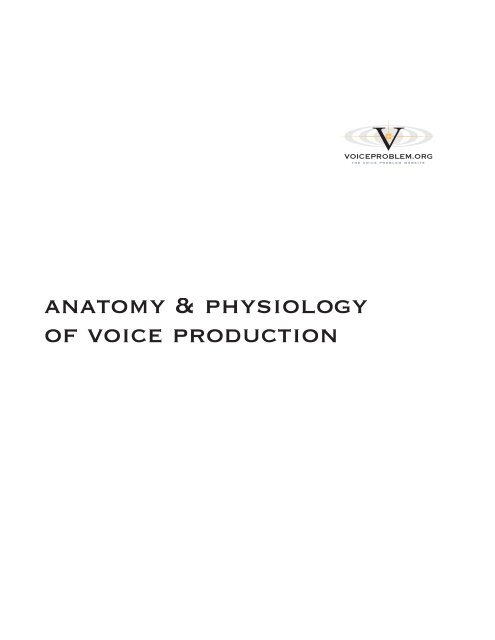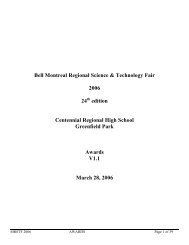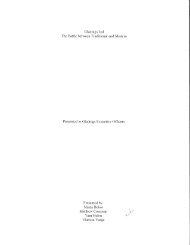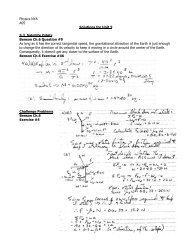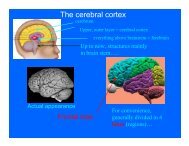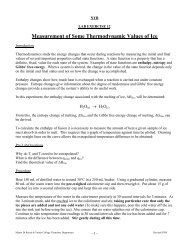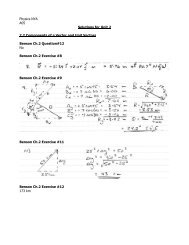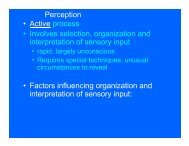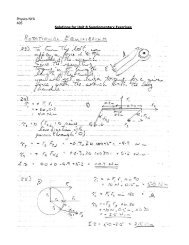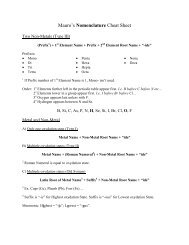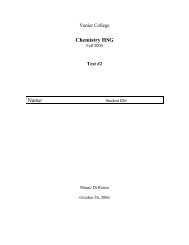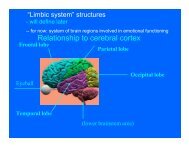anatomy & physiology of voice production
anatomy & physiology of voice production
anatomy & physiology of voice production
You also want an ePaper? Increase the reach of your titles
YUMPU automatically turns print PDFs into web optimized ePapers that Google loves.
<strong>anatomy</strong> & <strong>physiology</strong><br />
<strong>of</strong> <strong>voice</strong> <strong>production</strong><br />
�<br />
VOICEPROBLEM.ORG<br />
t h e v o i c e p r o b l e m w e b s i t e
Anatomy and Physiology <strong>of</strong> Voice Production: Highlights<br />
Understanding Voice Disorders<br />
Knowing how normal <strong>voice</strong> is produced and the roles the <strong>voice</strong> box and its parts play in speaking and singing helps patients<br />
understand their <strong>voice</strong> disorders.<br />
Voice "As We Know It"<br />
The "spoken word" results from three components <strong>of</strong> <strong>voice</strong> <strong>production</strong>: <strong>voice</strong>d sound, resonance, and articulation.<br />
Voiced sound: The basic sound produced by vocal fold vibration is called "<strong>voice</strong>d sound." This is frequently described as a<br />
"buzzy" sound. Voiced sound for singing differs significantly from <strong>voice</strong>d sound for speech.<br />
Resonance: Voice sound is amplified and modified by the vocal tract resonators (the throat, mouth cavity, and nasal<br />
passages). The resonators produce a person's recognizable <strong>voice</strong>.<br />
Articulation: The vocal tract articulators (the tongue, s<strong>of</strong>t palate, and lips) modify the <strong>voice</strong>d sound. The articulators produce<br />
recognizable words.<br />
Voice Mechanism<br />
Speaking and singing involve a <strong>voice</strong> mechanism that is composed <strong>of</strong> three subsystems. Each subsystem is composed <strong>of</strong> different<br />
parts <strong>of</strong> the body and has specific roles in <strong>voice</strong> <strong>production</strong>.<br />
Three Voice Subsystems<br />
Subsystem Voice Organs Role in Sound Production<br />
Air pressure<br />
system<br />
Vibratory<br />
system<br />
Resonating<br />
system<br />
Diaphragm, chest muscles, ribs,<br />
abdominal muscles<br />
Lungs<br />
Voice box (larynx)<br />
Vocal folds<br />
Vocal tract: throat (pharynx), oral<br />
cavity, nasal passages<br />
Key Function <strong>of</strong> the Voice Box<br />
Provides and regulates air pressure to cause vocal folds to vibrate<br />
Vocal folds vibrate, changing air pressure to sound waves producing "<strong>voice</strong>d<br />
sound," frequently described as a "buzzy sound"<br />
Varies pitch <strong>of</strong> sound<br />
Changes the "buzzy sound" into a person's recognizable <strong>voice</strong><br />
The key function <strong>of</strong> the <strong>voice</strong> box is to open and close the glottis (the space between the two vocal folds).<br />
Role in breathing: Open glottis<br />
Role in cough reflex: Close, then open glottis<br />
Role in swallowing: Close glottis<br />
Role in <strong>voice</strong>: Close glottis and adjust vocal fold tension (plus additional functions for singing)
Key Components <strong>of</strong> the Voice Box<br />
Cartilages<br />
Muscles<br />
Nerves<br />
Vocal folds<br />
Abnormalities or Changes in the Vibratory System Result in Voice Disorders<br />
Breakdowns can occur in any one or all three subsystems <strong>of</strong> <strong>voice</strong> <strong>production</strong>. This patient education series focuses on <strong>voice</strong><br />
disorders, specifically breakdowns in the vibratory system.
Understanding How Voice Is Produced<br />
Voice as We Know It = Voiced Sound + Resonance + Articulation<br />
The "spoken word" results from three components <strong>of</strong> <strong>voice</strong> <strong>production</strong>: <strong>voice</strong>d sound, resonance, and articulation.<br />
Voiced sound: The basic sound produced by vocal fold vibration is called "<strong>voice</strong>d sound." This is frequently described as a<br />
"buzzy" sound. Voiced sound for singing differs significantly from <strong>voice</strong>d sound for speech.<br />
Resonance: Voiced sound is amplified and modified by the vocal tract resonators (the throat, mouth cavity, and nasal<br />
passages). The resonators produce a person's recognizable <strong>voice</strong>.<br />
Articulation: The vocal tract articulators (the tongue, s<strong>of</strong>t palate, and lips) modify the <strong>voice</strong>d sound. The articulators produce<br />
recognizable words.<br />
Voice Depends on Vocal Fold Vibration and Resonance<br />
Sound is produced when aerodynamic phenomena cause vocal folds to vibrate rapidly in a sequence <strong>of</strong> vibratory cycles with a<br />
speed <strong>of</strong> about:<br />
110 cycles per second or Hz (men) = lower pitch<br />
180 to 220 cycles per second (women) = medium pitch<br />
300 cycles per second (children) = higher pitch<br />
higher <strong>voice</strong>: increase in frequency <strong>of</strong> vocal fold vibration<br />
louder <strong>voice</strong>: increase in amplitude <strong>of</strong> vocal fold vibration<br />
Vibratory Cycle = Open + Close Phase<br />
The vocal fold vibratory cycle has phases that include an orderly sequence <strong>of</strong> opening and closing the top and bottom <strong>of</strong> the vocal<br />
folds, letting short puffs <strong>of</strong> air through at high speed. Air pressure is converted into sound waves.<br />
Not Like a Guitar String<br />
Vocal folds vibrate when excited by aerodynamic phenomena; they are not plucked like a guitar string. Air pressure from the lungs<br />
controls the open phase. The passing air column creates a trailing "Bernoulli effect," which controls the close phase.<br />
The Process <strong>of</strong> Voice<br />
Voice <strong>production</strong> involves a three-step process.<br />
1. A column <strong>of</strong> air pressure is moved towards the vocal folds: Air is moved out <strong>of</strong> the lungs and towards the vocal folds by<br />
coordinated action <strong>of</strong> the diaphragm, abdominal muscles, chest muscles, and rib cage<br />
2. Vocal fold vibration – sequence <strong>of</strong> vibratory cycles:<br />
Vocal folds are moved to midline by <strong>voice</strong> box muscles, nerves, and cartilages<br />
The vibratory cycle occurs repeatedly; one vibratory cycle is as follows:<br />
1. Column <strong>of</strong> air pressure opens bottom <strong>of</strong> vocal folds<br />
2. Column <strong>of</strong> air continues to move upwards, now towards the top <strong>of</strong> vocal folds, and opens the top<br />
3. The low pressure created behind the fast-moving air column produces a "Bernoulli effect" which causes the bottom<br />
to close, followed by the top<br />
4. Closure <strong>of</strong> the vocal folds cuts <strong>of</strong>f the air column and releases a pulse <strong>of</strong> air<br />
5. New cycle repeats
The rapid pulses <strong>of</strong> air created by repeat vibratory cycles produce "<strong>voice</strong>d sound" which is really just a buzzy sound,<br />
which is then amplified and modified by the vocal tract resonators, producing <strong>voice</strong> "as we know it." (See table below)<br />
Loudness: Increase in air flow "blows" vocal folds wider apart, which stay apart longer during a vibratory cycle –<br />
thus increasing amplitude <strong>of</strong> the sound pressure wave<br />
Pitch: Increase in frequency <strong>of</strong> vocal fold vibration raises pitch<br />
1 Column <strong>of</strong> air pressure moves<br />
upward towards vocal folds in "closed"<br />
position<br />
2, 3 Column <strong>of</strong> air pressure opens<br />
bottom <strong>of</strong> vibrating layers <strong>of</strong> vocal<br />
folds; body <strong>of</strong> vocal folds stays in<br />
place<br />
4, 5 Column <strong>of</strong> air pressure continues<br />
to move upward, now towards the top<br />
<strong>of</strong> vocal folds, and opens the top<br />
Diagram <strong>of</strong> Vocal Fold Vibration<br />
(click for larger image)<br />
6–10 The low pressure created behind<br />
the fast-moving air column produces<br />
a Bernoulli effect which causes the<br />
bottom to close, followed by the top<br />
10 Closure <strong>of</strong> the vocal folds cuts <strong>of</strong>f<br />
the air column and releases a pulse <strong>of</strong><br />
air<br />
New vibratory cycle – repeat 1-10<br />
In the closed position (---) maintained by muscle ( ), the key vibrating layer <strong>of</strong> the vocal fold ( ) opens and closes in a<br />
cyclical, ordered and even manner (1 – 10) as a column <strong>of</strong> air pressure ( ) from the lungs below flows through. This very rapid<br />
ordered closing and opening produced by the column <strong>of</strong> air is referred to as the mucosal wave. The lower edge opens first (2-3)<br />
followed by the upper edge thus letting air flow through (4-6). The air column that flows through creates a "Bernouli effect"<br />
which causes the lower edge to close (7-9) as it escapes upwards. The escaping "puffs <strong>of</strong> air" (10) are converted to sound which<br />
is then transformed into <strong>voice</strong> by vocal tract resonators.<br />
Any change that affects this mucosal wave – stiffness <strong>of</strong> vocal fold layers, weakness or failure <strong>of</strong> closure, imbalance<br />
between R and L vocal folds from a lesion on one vocal fold – causes <strong>voice</strong> problems. (For more information, see<br />
Anatomy: How Breakdowns Result in Voice Disorders.)<br />
3. Vocal tract – resonators and articulators: The nose, pharynx, and mouth amplify and modify sound, allowing it to take on<br />
the distinctive qualities <strong>of</strong> <strong>voice</strong><br />
Similarities With Trombone<br />
The way that <strong>voice</strong> is produced is analogous to the way that sound is produced by a trombone. The trombone player produces<br />
sound at the mouthpiece <strong>of</strong> the instrument with his lips vibrating from air that passes from the mouth. The vibration within the<br />
mouthpiece produces sound, which is then altered or "shaped" as it passes throughout the instrument. As the slide <strong>of</strong> the trombone<br />
is changed, the sound <strong>of</strong> the musical instrument is similarly changed.<br />
Amazing Outcomes <strong>of</strong> Human Voice<br />
The human <strong>voice</strong> can be modified in many ways. Consider the spectrum <strong>of</strong> sounds – whispering, speaking, orating, shouting – as<br />
well as the different sounds that are possible in different forms <strong>of</strong> vocal music, such as rock singing, gospel singing, and opera<br />
singing.
Key Factors for Normal Vocal Fold Vibration<br />
To vibrate efficiently vocal folds need to be:<br />
At the midline or "closed": Failure to move vocal folds to the midline, or any lesion which prevents the vocal fold edges<br />
from meeting, allows air to escape and results in breathy <strong>voice</strong>.<br />
Key players: muscles, cartilages, nerves<br />
Pliable: The natural "built-in" elasticity <strong>of</strong> vocal folds makes them pliable. The top, edge, and bottom <strong>of</strong> the vocal folds that<br />
meet in the midline and vibrate need to be pliable. Changes in vocal fold pliability, even if limited to just one region or<br />
"spot," can cause <strong>voice</strong> disorders, as seen in vocal fold scarring.<br />
Key players: epithelium, superficial lamina propria<br />
"Just right" tension: Inability to adjust tension during singing can cause a failure to reach high notes or breaks in <strong>voice</strong>.<br />
Key players: muscle, nerve, cartilages<br />
"Just right" mass: Changes in the s<strong>of</strong>t tissue bulk <strong>of</strong> the vocal folds – such as decrease or thinning as in scarring or<br />
increase or swelling, as in Reinke's edema, produce many <strong>voice</strong> symptoms – hoarseness, altered <strong>voice</strong> pitch, effortful<br />
phonation, etc. (For more information, see Vocal Fold Scarring and Reinke's Edema.)<br />
Key players: muscles, nerves, epithelium, superficial lamina propria
Anatomy: Vocal Fold Vibration and Resonance<br />
Vocal Fold Vibration and Resonance<br />
This diagram can be found in Anatomy and Physiology <strong>of</strong> Voice Production: Understanding How Voice is Produced.
Learning About the Voice Mechanism<br />
Voice Mechanism<br />
Speaking and singing involve a <strong>voice</strong> mechanism that is composed <strong>of</strong> three subsystems. Each subsystem is composed <strong>of</strong> different<br />
parts <strong>of</strong> the body and has specific roles in <strong>voice</strong> <strong>production</strong>.<br />
Three Voice Subsystems<br />
Subsystem Voice Organs Role in Sound Production<br />
Air pressure<br />
system<br />
Vibratory<br />
system<br />
Resonating<br />
system<br />
Diaphragm, chest muscles, ribs,<br />
abdominal muscles<br />
Lungs<br />
Voice box (larynx)<br />
Vocal folds<br />
Vocal tract: throat (pharynx), oral<br />
cavity, nasal cavities<br />
Provides and regulates air pressure to cause vocal folds to vibrate<br />
Vocal folds vibrate, changing air pressure to sound waves producing "<strong>voice</strong>d<br />
sound," frequently described as a "buzzy sound"<br />
Varies pitch <strong>of</strong> sound<br />
Changes the "buzzy sound" into a person's recognizable <strong>voice</strong><br />
Diagram <strong>of</strong> Voice Subsystems
Air Pressure System<br />
The ability to produce <strong>voice</strong> starts with airflow from the lungs, which is coordinated by the action <strong>of</strong> the diaphragm and abdominal<br />
and chest muscles.<br />
Vibratory System<br />
The <strong>voice</strong> box (larynx) and vocal folds (sometimes called vocal cords) comprise the vibratory system <strong>of</strong> the <strong>voice</strong> mechanism.<br />
Resonating System<br />
The vocal tract is comprised <strong>of</strong> resonators which give a personal quality to the <strong>voice</strong>, and the modifiers or articulators which form<br />
sound into <strong>voice</strong>d sounds.<br />
Key Function <strong>of</strong> the Voice Box<br />
The key function <strong>of</strong> the <strong>voice</strong> box is to open and close the glottis (the space between the two vocal folds).<br />
Role in breathing: open glottis<br />
Voice box brings both vocal folds apart during breathing.<br />
Role in cough reflex: close, then open glottis<br />
Voice box closes the glottis to build up pressure, then opens it for the forceful expelling <strong>of</strong> air during cough.<br />
Role in swallowing: close glottis<br />
Voice box coordinates closing the glottis by bringing both vocal folds to the midline to prevent choking during<br />
swallowing.<br />
Role in <strong>voice</strong>: close glottis and adjust vocal fold tension<br />
Voice box brings both vocal folds to the midline to allow vocal fold vibration during speaking and singing.<br />
Voice box adjusts vocal fold tension to vary pitch (how high or low the <strong>voice</strong> is) and changes in volume (such as loud<br />
<strong>voice</strong> <strong>production</strong>).<br />
Key Components <strong>of</strong> the Voice Box<br />
Cartilages<br />
Muscles<br />
Nerves<br />
Vocal Folds<br />
Voice Box Cartilages<br />
There are three cartilages within the larynx.<br />
1. Thyroid Cartilage<br />
Forms the front portion <strong>of</strong> the larynx<br />
Most forward part comprises the "Adam's apple"<br />
Houses the vocal folds<br />
Vocal folds attach just below the Adam's apple<br />
2. Cricoid Cartilage<br />
Below the thyroid cartilage<br />
Ring-like: front to back
Becomes taller in the back <strong>of</strong> the <strong>voice</strong> box<br />
Platform for the arytenoid cartilages<br />
3. Arytenoid Cartilages (left and right)<br />
Pair <strong>of</strong> small pyramid-shaped cartilages<br />
Connect with the cricoid cartilage at the back <strong>of</strong> the vocal folds<br />
With the cricoid cartilage, forms the cricoarytenoid joint<br />
Voice Box Muscles<br />
Voice box muscles are named according to the cartilages to which they are attached.<br />
Voice Box Muscles – Cartilage Attachments, Role, Nerve Input<br />
Muscles, Cartilage Attachments, and their Main Roles Nerve Input<br />
Muscles That Position Vocal Folds in the Midline During Sound Production (close glottis)<br />
Thyroarytenoid muscle<br />
R & L muscles; attached to thyroid and arytenoid cartilages on each side<br />
Action shortens and relaxes vocal ligament<br />
Note: deeper inner fibers referred to as "vocalis muscle" (see below)<br />
Lateral cricoarytenoid muscle (R & L muscles)<br />
Attached to cricoid and arytenoid cartilage on each side<br />
Closes or adducts vocal folds<br />
Inter-arytenoid muscle (transverse and oblique)<br />
Attached between right and left arytenoid cartilages<br />
Closes inlet <strong>of</strong> larynx<br />
These muscles work coordinately to position both vocal folds in the midline for vocal fold vibration<br />
during sound <strong>production</strong>.<br />
Role in <strong>voice</strong> <strong>production</strong><br />
Role in protection <strong>of</strong> airway during swallowing<br />
Muscle That Moves Vocal Folds Apart (open glottis)<br />
Posterior cricoarytenoid muscle<br />
Attached to cricoid and arytenoid cartilages<br />
o Move arytenoid cartilages so as to move both vocal folds apart, "open" <strong>of</strong> abduct vocal<br />
folds<br />
Role in breathing<br />
Muscles That Adjust Length and Tension <strong>of</strong> Vocal Folds<br />
Vocalis muscle (derived from inner and deeper fibers <strong>of</strong> thyroarytenoid msucle]<br />
Alters vocal fold tension/relaxation during speaking or singing<br />
Role in <strong>voice</strong> <strong>production</strong><br />
Recurrent laryngeal nerve<br />
(RLN)<br />
Recurrent laryngeal nerve<br />
(RLN)<br />
Recurrent laryngeal nerve<br />
(RLN)
Cricothyroid muscle<br />
Attached to cricoid and thyroid cartilages<br />
Tilts the thyroid cartilage, thus increasing tension <strong>of</strong> vocal folds<br />
Role in high-pitch singing<br />
Role in pitch glide in singing<br />
Nerve Input to the Voice Box<br />
Diagram <strong>of</strong> Voice Box Cartilages and Muscles<br />
Voice box muscles are named according to the cartilages to which they are attached.<br />
The brain coordinates <strong>voice</strong> <strong>production</strong> through specific nerve connections and signals<br />
Signals to the <strong>voice</strong> box for moving <strong>voice</strong> box muscles (motor nerves) come from:<br />
Motor branches <strong>of</strong> recurrent laryngeal nerve (RLN)<br />
Superior laryngeal nerve (SLN)<br />
Superior laryngeal nerve<br />
Signals from the <strong>voice</strong> box structures for feeling (sensory nerves) travel through sensory branches <strong>of</strong> the RLN and SLN<br />
Key Information<br />
"Recurrent" laryngeal nerve: The recurrent laryngeal nerve is so named because on the left side <strong>of</strong> the body it travels<br />
down into the chest and comes back (recurs) up into the neck to end at the larynx. [see figure below]<br />
Long path <strong>of</strong> left RLN: The circuitous path <strong>of</strong> the left RLN throughout the chest is one reason why any type <strong>of</strong> open-chest<br />
(SLN)
surgery places patients at risk for a recurrent laryngeal nerve injury, which would result in vocal fold paresis or paralysis.<br />
[see figure below] (For more information, see Vocal Fold Scarring and Vocal Fold Paresis / Paralysis.)<br />
Shorter path <strong>of</strong> right RLN: The right recurrent laryngeal nerve continues in the upper chest and loops around the right<br />
subclavian artery, just behind the clavicle (collarbone), then travels the short distance in the neck to the larynx.<br />
Vocal Folds<br />
Diagram <strong>of</strong> Key Nerves for Voice Production<br />
This diagram shows the "long path" <strong>of</strong><br />
the left recurrent laryngeal nerve (left<br />
RLN). After it branches <strong>of</strong>f the vagus<br />
nerve, the left RLN loops around the<br />
aortic arch in the chest cavity and then<br />
courses back into the neck.<br />
This long course makes it at higher risk<br />
for injury compared with the shorter<br />
course <strong>of</strong> the right RLN which does not<br />
run through the chest cavity.<br />
The left and right vocal folds are housed within the larynx. The vocal folds include three distinct layers that work together to<br />
promote vocal fold vibration.<br />
1. Covering/mucosa: Loose structure that is key to vocal fold vibration during sound <strong>production</strong>; is composed <strong>of</strong>:<br />
Epithelium<br />
Basement membrane<br />
Superficial lamina propria (SLP)<br />
2. Vocal ligament: The vocal ligament is composed <strong>of</strong>:<br />
Intermediate lamina propria<br />
Deep lamina propria (contains collagen fibers that are stronger and more rigid than the superficial lamina propria)<br />
3. Body: The vocal fold body is composed <strong>of</strong> the thyroarytenoid muscle. This muscle helps close the glottis and regulate tension<br />
<strong>of</strong> vocal fold during speaking and/or singing. The medial portion <strong>of</strong> this muscle is also called "vocalis muscle."
"Wiper-Like" Movement <strong>of</strong> Vocal Folds<br />
Diagram <strong>of</strong> Vocal Folds<br />
The vocal folds move similar to a car's windshield wipers that are attached to the middle <strong>of</strong> the windshield and open outwards.<br />
(See figure below.)<br />
The front ends <strong>of</strong> both vocal folds are anchored to the front-middle (anterior commissure).<br />
The back ends <strong>of</strong> both vocal folds are anchored to the arytenoid cartilages.<br />
When arytenoids are moved to the open position by the posterior cricoarytenoid muscle, vocal folds open, resulting in glottal<br />
opening.<br />
When arytenoids are closed by the lateral cricoarytenoid and inter arytenoid muscles, vocal folds are brought to the midline<br />
resulting in glottal closure.
Vocal Folds (vf) Opening and Closing
How Breakdowns Result in Voice Disorders<br />
In Brief<br />
Voice disorders refer to breakdowns in the vibratory system. Breakdowns can affect any one or all <strong>of</strong> the three subsystems <strong>of</strong> <strong>voice</strong><br />
<strong>production</strong>.<br />
Air Pressure System<br />
If the airflow source is weak or inefficient (making it difficult to push enough air out <strong>of</strong> lungs), the <strong>voice</strong> will be weak and<br />
hampered by shortness <strong>of</strong> breath.<br />
For example: Patients with asthma, lung cancer, emphysema and other lung conditions <strong>of</strong>ten find it difficult to speak loud or<br />
for long periods <strong>of</strong> time.<br />
Vibratory System<br />
Any compromise or change to vocal fold vibration causes hoarseness and other <strong>voice</strong> symptoms.<br />
For example: Patients with stiffness in the vocal folds from swelling from a common cold develop hoarseness.<br />
For example: When focal folds cannot come perfectly together from partial nerve input loss, air leak occurs and the <strong>voice</strong> is<br />
"breathy."<br />
Resonating System or Vocal Tract<br />
A breakdown <strong>of</strong> the vocal tract can affect <strong>voice</strong> quality.<br />
For example: When nasal passageways are swollen and inflamed during the "common cold," the <strong>voice</strong> takes on a nasal<br />
quality.<br />
Making Sense <strong>of</strong> It All<br />
The following are a few examples depicting how breakdowns result in <strong>voice</strong> disorders and a few <strong>of</strong> the many possible <strong>voice</strong><br />
symptoms.<br />
Correlating Anatomy, Voice Function, Abnormalities, and Possible Voice Disorder Symptoms<br />
Sound Process Brief Description<br />
Generating<br />
Air Pressure<br />
"Breath Support"<br />
Coordinated functions <strong>of</strong> diaphragm,<br />
abdominal and chest muscles, lungs<br />
and chest cavity move air column<br />
upwards through vocal folds<br />
A Glimpse – "who<br />
does what" in Sound<br />
Production<br />
Diaphragm, abdominal<br />
and chest muscles move<br />
air into and out <strong>of</strong> lungs<br />
Lungs are the organs for<br />
air<br />
Bronchi and trachea are<br />
the passageway for air<br />
from lungs<br />
Examples <strong>of</strong><br />
"Breakdowns" that<br />
Affect Sound Process<br />
Lung disease<br />
Airway obstruction:<br />
asthma, subglottic<br />
stenosis<br />
Paresis/paralysis <strong>of</strong><br />
muscles<br />
Possible<br />
Symptoms<br />
Shortness<br />
<strong>of</strong> breath<br />
Weak <strong>voice</strong>
Glottic<br />
Closure<br />
Position <strong>of</strong> vocal<br />
folds<br />
Vocal Fold<br />
Vibration<br />
Produces<br />
Voiced<br />
Sound<br />
Voice<br />
Volume or<br />
Loudness<br />
Voice Pitch<br />
or<br />
Highness /<br />
Lowness<br />
Vocal Fold Position Critical<br />
Vocal folds are in closed position for<br />
speech or singing<br />
[Note: Vocal folds are open for<br />
breathing]<br />
Wavelike Vibration from Bottom to<br />
Top–repeat vibratory cycles<br />
With each vocal fold vibratory cycle, a<br />
puff <strong>of</strong> air escapes, producing <strong>voice</strong><br />
sound ("buzzy sound")<br />
Singing <strong>voice</strong> produces unique sound<br />
spectra (singing formants) that are<br />
distinct from spoken <strong>voice</strong><br />
Amplitude <strong>of</strong> Sound Waves<br />
Loudness is achieved by:<br />
Increasing air pressure/flow<br />
Increasing vocal fold resistance<br />
Frequency <strong>of</strong> Sound Waves<br />
Increased tension for high notes (high<br />
frequency)<br />
Decreased tension for low notes (low<br />
frequency)<br />
Greater air pressure and increased<br />
tension for high notes<br />
Laryngeal muscles<br />
contract to close vocal<br />
folds<br />
Arytenoid cartilages pivot<br />
to move vocal folds<br />
towards midline<br />
["closed"]<br />
RLN and SLN bring nerve<br />
inputs to muscles<br />
Vocal fold mass and<br />
edge contribute to glottic<br />
closure<br />
Superficial lamina<br />
propria is the main<br />
vibrating layer in vocal<br />
fold mucosa<br />
Vocal fold pliability is<br />
critical for vibration<br />
Vocal fold surface<br />
integrity allows mucosal<br />
wave propagation<br />
Vocal fold mass and<br />
edge contribute to glottic<br />
closure<br />
Breath support<br />
Laryngeal muscles<br />
contract to adjust<br />
tension <strong>of</strong> vocal folds<br />
Vocal fold elasticity<br />
allows folds to "open<br />
wider" and "stay apart"<br />
longer<br />
Laryngeal muscles<br />
contract to adjust<br />
tension <strong>of</strong> vocal<br />
folds–especially for high<br />
notes<br />
Vocal fold<br />
elasticity/pliability<br />
Vocal fold edge integrity<br />
Paresis/paralysis–RLN/SLN<br />
Muscle weakness<br />
Neurological diseases;<br />
muscular disorders<br />
Arytenoid arthritis<br />
Vocal fold granuloma<br />
Vocal fold nodules,<br />
polyps, cysts<br />
Vocal fold atrophy<br />
Vocal fold scarring<br />
Vocal fold scar<br />
Vocal fold lesions: cysts,<br />
nodules, polyps,<br />
papilloma<br />
Vocal fold granuloma<br />
Swelling and inflammation<br />
(reflux laryngitis, viral<br />
laryngitis)<br />
Reinke's edema<br />
Paresis/paralysis<br />
Hemorrhage, vascular<br />
ectasias<br />
Vocal fold scar<br />
Paresis/paralysis<br />
Vocal fold lesions: cysts,<br />
nodules, polyps,<br />
papilloma<br />
Vocal fold granuloma<br />
Swelling and inflammation<br />
(reflux laryngitis, viral<br />
laryngitis)<br />
SLN paresis/paralysis<br />
Vocal fold scar<br />
Reinke's edema<br />
Vocal fold lesions<br />
Hoarseness<br />
Breathiness<br />
Effortful<br />
phonation<br />
Vocal<br />
fatigue<br />
Diplophonia<br />
Hoarseness<br />
Effortful<br />
phonation<br />
Weak <strong>voice</strong><br />
Speaking<br />
<strong>voice</strong> lower<br />
than usual<br />
"Vocal fry"<br />
Voice<br />
fatigue<br />
Unable to<br />
project<br />
<strong>voice</strong><br />
Weak <strong>voice</strong><br />
Voice<br />
breaks<br />
Unable to<br />
hit high<br />
notes<br />
Loss <strong>of</strong><br />
glissando<br />
Voice<br />
breaks
Voice<br />
Quality or<br />
Timbre<br />
Person's "Own" Voice<br />
Vocal tract resonators amplify and<br />
modify <strong>voice</strong>d sound, giving personal<br />
quality to a person's <strong>voice</strong><br />
e.g., John's <strong>voice</strong> not equal to Jim's<br />
<strong>voice</strong><br />
Vocal fold<br />
elasticity/pliability<br />
Vocal fold resistance<br />
Vocal fold mass<br />
Person's vocal fold<br />
features: e.g., stiffness,<br />
bulk, size<br />
Vocal tract resonators<br />
(throat, oral cavity,<br />
nasal cavities)<br />
Vocal fold scar<br />
Vocal fold inflammation<br />
Reinke's Edema<br />
Common cold<br />
Hoarseness,<br />
etc.<br />
Off<br />
expected<br />
pitch<br />
Nasal<br />
quality to<br />
<strong>voice</strong>
Advisory Note<br />
Patient education material presented here does not substitute for medical consultation or examination, nor is this material intended<br />
to provide advice on the medical treatment appropriate to any specific circumstances.<br />
All use <strong>of</strong> this site indicates acceptance <strong>of</strong> our Terms <strong>of</strong> Service.


